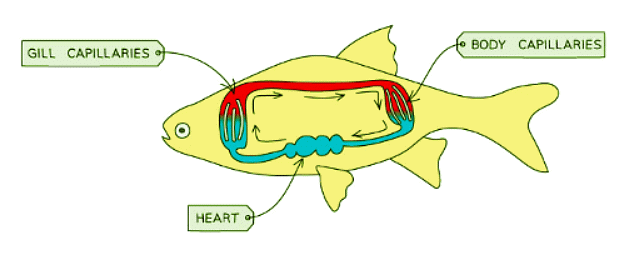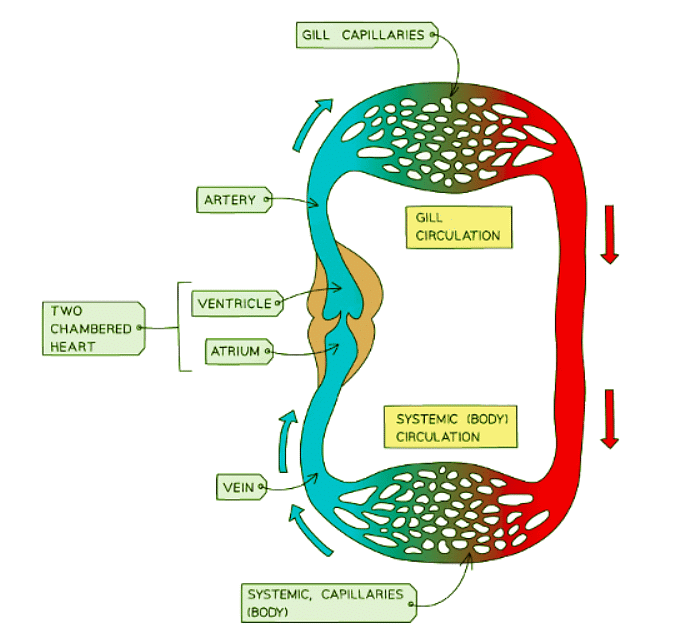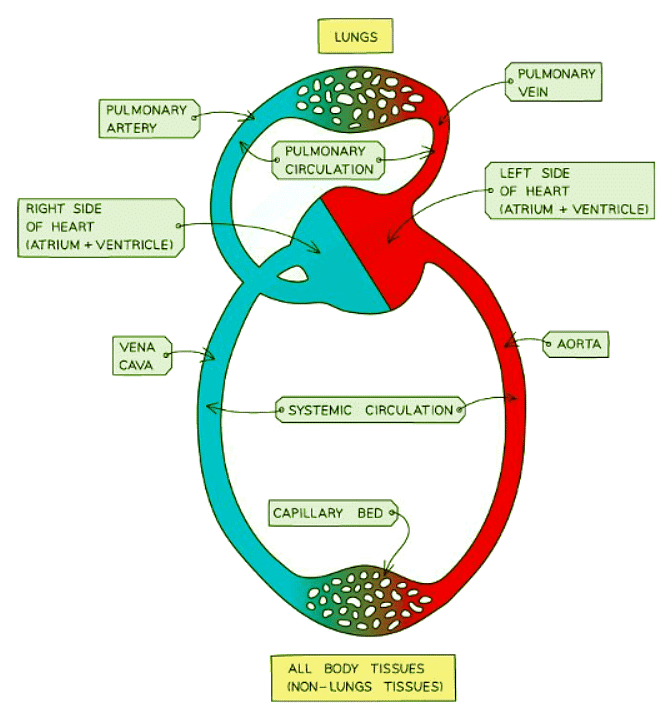Class 10 Exam > Class 10 Notes > Biology for GCSE/IGCSE > Circulatory System - 2
Circulatory System - 2 | Biology for GCSE/IGCSE - Class 10 PDF Download
Circulatory Systems of Fish & Mammals: Extended
Circulatory Systems in Fish
- Fish possess a heart comprising two chambers and follow a single circulation system.
- Consequently, each circulation of blood through the body involves only one passage through the heart.
The single circulatory system in fish:



Circulatory systems in Mammals
- Mammals possess a four-chambered heart and exhibit a double circulation system.
- Hence, during each complete circuit of the body, blood circulates through the heart twice.
- Deoxygenated blood from the body is received by the right side of the heart and pumped to the lungs (pulmonary circulation).
- Conversely, oxygenated blood from the lungs is received by the left side of the heart and pumped to the body (systemic circulation).
The double circulatory system in mammals:

 Advantages of Double Circulation: Extended
Advantages of Double Circulation: Extended
- As blood navigates the intricate network of tiny capillaries within the lungs, it experiences a significant drop in pressure initially imparted by the heart's pumping action. Consequently, its velocity diminishes.
- Re-routing this blood back to the heart post-lung circulation facilitates a pressure boost before dispatching it to the body. This process ensures a prompt and efficient delivery of oxygen and glucose to cells for respiration.
Question for Circulatory System - 2Try yourself: How many chambers does the heart of a fish possess?View Solution
The document Circulatory System - 2 | Biology for GCSE/IGCSE - Class 10 is a part of the Class 10 Course Biology for GCSE/IGCSE.
All you need of Class 10 at this link: Class 10
|
110 videos|210 docs|33 tests
|
FAQs on Circulatory System - 2 - Biology for GCSE/IGCSE - Class 10
| 1. What are the main differences between the circulatory systems of fish and mammals? |  |
Ans. Fish have a single-loop circulatory system, while mammals have a double-loop circulatory system. Fish have a two-chambered heart, while mammals have a four-chambered heart. Fish have gills for respiration, while mammals have lungs.
| 2. How does double circulation benefit mammals compared to single circulation in fish? |  |
Ans. Double circulation allows mammals to separate oxygenated and deoxygenated blood, ensuring more efficient oxygen delivery to the body's tissues. This allows mammals to have a higher metabolic rate and maintain a constant body temperature, which is crucial for their survival in various environments.
| 3. What are the advantages of having a four-chambered heart in mammals? |  |
Ans. A four-chambered heart allows for complete separation of oxygenated and deoxygenated blood, ensuring more efficient oxygen delivery to the body's tissues. This enhances the overall efficiency of the circulatory system, allowing mammals to have higher energy levels and better endurance.
| 4. How do fish and mammals differ in terms of their respiratory systems and how does this relate to their circulatory systems? |  |
Ans. Fish have gills for respiration, which extract oxygen from water, while mammals have lungs for respiration, which extract oxygen from air. This difference in respiratory organs directly influences the type of circulatory system they have, with fish having a single-loop system to maximize oxygen extraction from water, and mammals having a double-loop system to ensure efficient oxygen delivery from the lungs to the body tissues.
| 5. What role does the circulatory system play in maintaining homeostasis in both fish and mammals? |  |
Ans. The circulatory system in both fish and mammals plays a crucial role in maintaining homeostasis by regulating the transport of oxygen, nutrients, hormones, and waste products throughout the body. It helps maintain a stable internal environment by regulating temperature, pH levels, and electrolyte balance.
Related Searches















